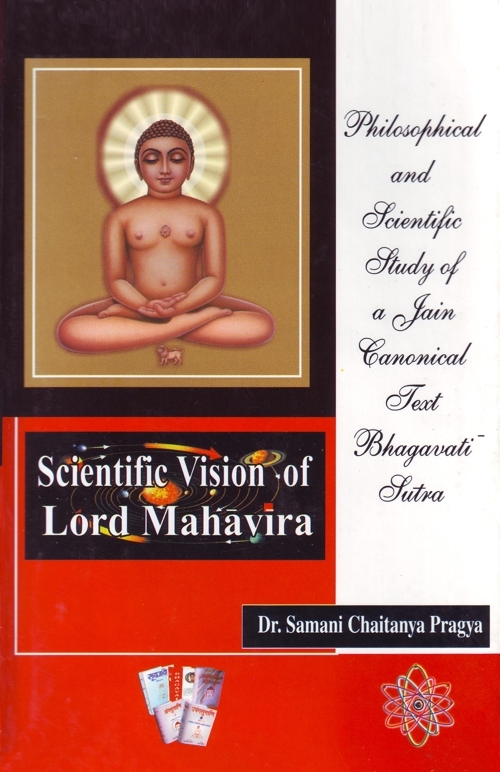As far as the queation of the end of the universe is concerned, the reply given by the Lord Mahāvira is non-absolutistic. Accordingly, the universe is with and without end. The ascetic Skandaka once asked Lord Mahavir—"Is the world with end? Is the world without end?"
The Lord, "O Skandaka, the world has been propounded by me in four ways, viz; with respect to substance, space, time and modes. With respect to substance, the world is a unitary entity and has an end.
With respect to space, the world is 107x107 times innumerable Yojanas[*] in length and breadth and 107x107 times innumerable Yojanas in circumference. Thus, it has an end. The modern science also proves the universe finit. Accordingly, the diameter of the universe is of 35 billion light years.
With respect to time, the universe was never non-existent; it is never non-existent;it will never be non-existentin future—it was, it is and it will be. It is eternal, fixed, perennial, indestructible, impershable, ever present and persistent and thus it has no end i.e., it is infinite.
With respect to modes, the world has an infinite number of colour-modes, an infinite number of smell-modes, an infinite number of taste-modes, an infinite number of touch-modes, an infinite number of configuration-modes, an infinite number of heavy-cum-light-moeds and an infinite number of neither-heavy-nor-light-modes; and thus it has no end, i.e., it is infinite.
Thus, O Skandaka, with respect to substance, the world has an end; with respect to space, it has an end, with respect to time, the world has no end; and with respect to mode, it has no end."[40]
The concept of kālaloka and bhāvaloka are scientific and worthy to note in the respect of the universe. kālaloka i.e. the universe with respect to time can be understood easily under the view of Modern Science about the universe. According to the modern science, the universe is gradually running down in the material sense of the word, known as the entropy that is tending towards the maximum. Mexwell has proved this mathematically from the second law of thermodynamics. In nature, heat is constantly flowing without interruption from a body at a higher temperature to a body at a lower temperature and vice-versa. Thus, there is a tendency towards equalization of temperature and pressure all over the universe.[41]
The sum total of energy in the universe will be the same as before but it will not be functional. No motion of any kind will be possible. The whole universe together with its entire inmate will come to a standstill. Living beings will neither be able to move nor to breathe. Life of all forms will be extinct. What is next? is a glaring question before the scientists. They believe that the universe cannot end. They think, some unknown force must rewind the clock of the universe, so that it may be set running once again. According to predominant schools of Indian philosophy, God does the rewinding, whereas, according to the Jain philosophy, the process is automatic. To explain the process Bh.S mentions certain words. The words are--niyae, akkhae, avvae, avaṭṭhie, nicce and sasae. [42] 'Niyae' means the universe is fixed, uniform and determined by its natural laws. The gradual decline of the universe is taking place only at the level of modes and not at the level of existence. It means the fundamental elements never cease to exist. Thus, the sum total of energy in the universe remains the same as before.[43] Like the word 'Niyae' the word 'Akkhae' is used to indicate the universe as indestructible. The word 'Avvae' shows that the universe is imperishable, no part of it ever perishes. The word 'Avaṭṭhie' speaks of its ever presence, free from evolution and devolution. The word 'Nicce' represents the persistence of the universe. It always exists because of its power of persistence. The word 'Sasae' indicates the universe as perennial. There is no point of time when it will not be. It is continuous. It only moves from the state of asending to desending and vice-versa. This process goes on forever in a cyclic order.
The recent scientific theories also show the process of expanding and shrinking universe in a cyclic way. According to Prof. L.C. Jain - the debate about the open or closed universe is unending. Any theory dealing with the evolution of universe holds that it was possibly once compressed into a very small and dense volume. Experimental evidence shows that the universe is expanding and galaxies are running away from one another. The farther away the galaxy, the faster is its speed of receding. Neverthless, the equations of the theory of relativity allow a shrinking universe as well.[44]
As far as bhāvaloka is concerned, Acharya Mahapragya has elaborately discussed it in his commentary of Bh.S.[45] Accordingly, the word "loka" stands for the universe in Jain canonical literature. Etymologically "loka" means what is visible.[46] So, the the world as modes is described through the modes of colour, smell etc. Mode is expressed as paryāya, Paryava, viśeṣa, dharma, paryaya, bheda and bhāva.[47] Mode is of two kinds: intrinsic (svabhāva) and extrinsic (vibhāva). Among the six fundamental entities soul and matter have both these types of modes, but other substances have only intrinsic modes.[48] Colour, smell, taste and touch—the four qualities are intrinsic modes of matter (pudgala). Unity, separation, number, configuration, conjunction and disjunction etc. are the extrinsic modes of matter. Similarly, knowledge, intuition, bliss and energy—these are the intrinsic modes of the soul and to be endowed with different bodies and senses are extrinsic modes of it. Both the modes are changeable and undergo infinite grades. An atom or a material cluster has infinite number of grades of black and other colours. Similarly, it has infinite number of grades of smell, taste and touch. Likewise the soul has infinite types of knowledge. We find several kinds of knowledge in one as well as in different beings.
These grades are found in the higher to lower and lower to higher degree. e.g. one atom which is of one degree black colour may change into two to infinite degree of blackness and vice-versa. The same applies to the other properties.
The heavy-cum-light mode is common to matter and soul associated with matter. The mode neither-heavy-nor-light is a specific quality or potency. A substance preserves its substancehood by means of this potency. The animate does not become inanimate nor vice-versa--the basis of this universal law is the mode called neithr-heavy-nor-light. It is on account of this potency that the qualities of a substance undergo six-fold increase and decrease without loosing their identity.[49] This potency has been designated as unamenable to speech, as continuing every moment[50] and acceptable on the authority of the scripture.[51] The mode called neither-heavy-nor-light has been designated as a mode of innate nature (svabhāva paryāya) and also an intrinsic mode of an entity (arthaparyāya). Literally, neither-heavy-nor-light means weightless. Neither-heavy-nor-light is also a type of body-making-karma (nāma-karma) which is also weightless but that is not intended here.
The beginningless intrinsic potency of undergoing transformation called 'neither-heavy-nor-light' exists in every substance. But it is also not intended to be spoken of here. What is intended here is the 'neither-heavy-nor-light' mode i.e. the regulating potency of 'heavy-cum-light'. This potency is weightless and also the regulator of the mode 'heavy-cum-light'. This potency is fond not only in the liberated soul but in the atom, a subtle material cluster or in a formless substance also.[52] In a mundane soul, both the modes, heavy-cum-light and neither-heavy-nor-light do exist. The former modes are due to the gross body and the letter modes i.e. neither-heavy-norlight exist in the karmic body and also in the soul.[53]
From the discussion it reveals that there are things or objects in the universe, which are weightless. Now, this view is getting support from scientific discoveries. In modern science, it has been discovered that there are some particles which have no mass and therefore no weight.[54]
Thus, according to the Bh.S' description, the universe is finit or with end in respect of substances and space. The universe is infinite or endless in respect of modes and time.
Bhagavatī Vṛtti; 2/45—vaṇṇapajjava'tti varṇaviśeṣā ekaguṇakālatvādagaḥ, evamanye'pi gurulaghuparyav-āstadviśeṣā bādaraskandhānāṃ, agurulaghuparyava aṇūnāṃ sūkṣmaṣkadhānāmamūrtānāṃ ca.
Ibid., 2/46—anaṅtā gurulaghuparyavā audārikadiśarīrāṇyāśritya, itare tu kārmaṇādidravyāṇi jīvāsvarūpaṃ cāśrityeti.
 Dr. Samani Chaitanya Pragya
Dr. Samani Chaitanya Pragya

